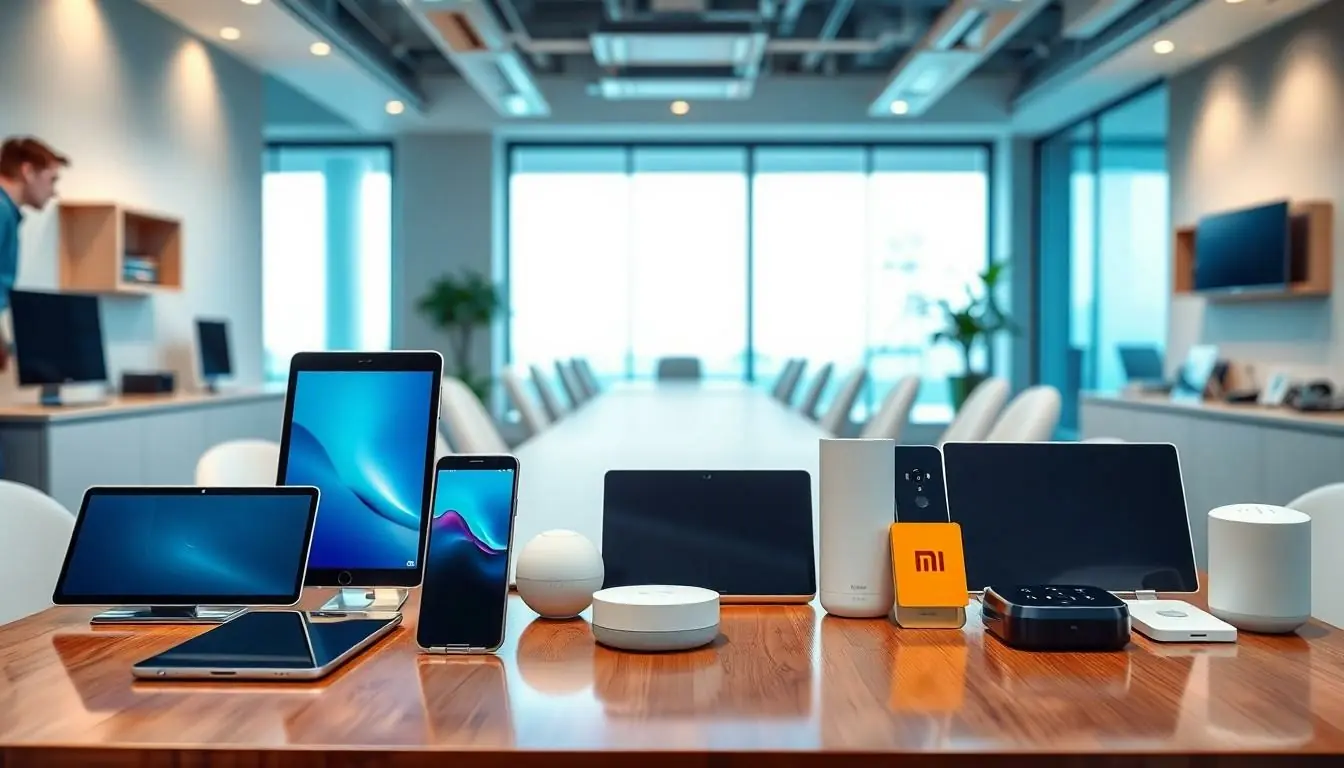In a world where gadgets seem to multiply faster than rabbits, consumer electronics companies are the wizards behind the curtain. They conjure up everything from sleek smartphones to smart fridges that can remind you to buy milk—because who hasn’t stared blankly into an empty fridge, wondering what went wrong? These companies aren’t just selling products; they’re crafting experiences that keep us connected, entertained, and sometimes scratching our heads in confusion.
With innovation at their fingertips, these tech titans are constantly pushing boundaries. Whether it’s the latest in wearable technology or home automation, they’re shaping how we live our everyday lives. So, buckle up as we dive into the electrifying world of consumer electronics, where every new release feels like unwrapping a gift on Christmas morning—minus the awkward family gatherings.
Table of Contents
ToggleOverview of Consumer Electronics Companies
Consumer electronics companies play a pivotal role in modern technology, offering diverse products that cater to various needs. Firms like Samsung, Apple, and Sony lead the market, innovating in segments such as smartphones, televisions, and wearable devices. Additionally, these companies invest heavily in research and development, ensuring they stay ahead of trends and consumer expectations.
The competitive landscape is marked by rapid evolution. Consumers now seek seamless integration of devices for enhanced usability and connectivity. Companies like Google and Amazon focus on smart home products, creating ecosystems that simplify everyday tasks. Moreover, the shift towards sustainability has influenced many firms, prompting them to develop energy-efficient products that minimize environmental impact.
Market data consistently shows growth in sectors such as wireless earbuds and fitness trackers. The demand for smart appliances also continues to rise, illustrating consumer interest in technology that makes daily life easier. Industry reports indicate that the global consumer electronics market reached a value of approximately 1 trillion dollars in 2022, and projections estimate steady growth in the coming years.
Collaboration among companies fosters innovation. Partnerships between tech giants and startups often lead to groundbreaking advancements, especially in artificial intelligence and augmented reality. These partnerships not only expand product offerings but also enhance the overall consumer experience.
Investors closely monitor trends within the sector. Notable shifts toward 5G technology and Internet of Things devices indicate significant opportunities for growth. Consumer electronics companies adapting to these emerging trends position themselves as leaders in this dynamic industry.
Key Players in the Industry

Numerous companies dominate the consumer electronics landscape, each contributing unique innovations and experiences.
Established Brands
Samsung holds a significant market share, offering a wide array of products like smartphones, tablets, and home appliances. Apple continually leads with high-quality consumer electronics, prominently known for its iPhones and Mac computers. Sony remains a key player, especially in the gaming sector with the PlayStation series and in audio products like TVs and headphones. LG excels in home entertainment systems and appliances, known for its innovative displays and user-friendly technologies. Research and development investments by these companies drive ongoing advancements, ensuring they meet consumer demands while remaining competitive.
Emerging Companies
Many emerging companies bring fresh ideas and solutions to the consumer electronics market. One notable name is Xiaomi, which rapidly gained traction with its affordable yet feature-rich smartphones. Another rising star, OnePlus, has earned a reputation for delivering high-performance devices at competitive prices. Companies like Nest and Ring focus on smart home technologies, enhancing home security and automation. With a strong emphasis on sustainability, firms such as Fairphone advocate for environmentally friendly production methods. These newcomers challenge established brands by offering innovative features and appealing pricing models, stimulating competition and driving industry evolution.
Market Trends and Innovations
Consumer electronics companies are constantly evolving, driven by new technologies and market demands. Significant trends highlight advancements in technology and a commitment to sustainability.
Technological Advancements
Artificial intelligence innovation continues to transform consumer electronics, enhancing device functionality and user experiences. Companies invest in smart home technologies, enabling seamless device integration. 5G technology creates opportunities for faster connectivity, impacting everything from smartphones to smart appliances. Virtual reality gadgets are gaining traction, appealing to gamers and technology enthusiasts. Emerging technologies, such as augmented reality, find applications in retail and education, reshaping consumer interactions. Wireless audio devices, particularly earbuds, see explosive growth, driven by consumer preference for high-quality sound and convenience. Gamers benefit from advancements in graphics and processing power, pushing the limits of gaming experiences.
Sustainability Practices
Sustainability practices are becoming essential in the consumer electronics industry as companies seek eco-friendly solutions. Many firms prioritize energy efficiency, developing products that consume less power. For example, LG champions energy-efficient home appliances, significantly reducing environmental impact. Companies like Fairphone focus on ethical production, utilizing sustainable materials and promoting fair labor practices. Additionally, recycling programs encourage consumers to return old devices, minimizing landfill waste. The industry sees collaboration among companies to create durable products that extend lifespans. A notable shift towards reducing electronic waste reflects consumer demand for responsible manufacturing practices. This focus on sustainability drives innovation, as firms seek to meet regulatory standards and enhance brand loyalty.
Consumer Preferences and Buying Behavior
Consumer preferences in the electronics market show a strong inclination towards quality and innovation. Buyers actively seek products that provide superior performance and unique features.
Impact of Reviews and Recommendations
Reviews significantly influence purchasing decisions in consumer electronics. Research indicates that approximately 79% of consumers trust online reviews as much as personal recommendations. When users share positive feedback on platforms like Amazon or tech blogs, it enhances a product’s credibility. Recommendations from influencers and industry experts drive awareness and interest, directly impacting sales. Social media platforms also play a crucial role in shaping perceptions, often leading customers to purchase based on peer experiences.
Price Sensitivity
Price sensitivity greatly affects consumer choices in the electronics sector. A substantial portion of shoppers, nearly 50%, prioritize affordability over brand loyalty. Customers often compare prices across various retailers before committing to a purchase. Discounts and promotions can sway decisions, prompting timely purchases of high-demand items. Economical options, offered by brands such as Xiaomi and OnePlus, attract budget-conscious consumers looking for value without sacrificing quality. Furthermore, consumers demonstrate increased interest in long-term savings through energy-efficient devices, reflecting their willingness to invest strategically based on initial cost versus long-term benefits.
The landscape of consumer electronics is rapidly evolving with companies striving to meet the ever-changing demands of tech-savvy consumers. As innovation drives competition, firms are increasingly focused on creating integrated experiences that enhance daily life. The emphasis on sustainability and energy efficiency is reshaping product development, making it a priority for both established giants and emerging players.
With advancements in technology such as AI and 5G, the future holds exciting possibilities for connectivity and functionality. As consumers continue to seek quality and affordability, companies must adapt to stay relevant in this dynamic market. The interplay between innovation and consumer preferences will undoubtedly shape the next chapter in the consumer electronics industry.





